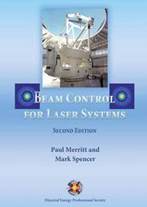Preface to Second Edition
This second edition of
Beam Control for Laser Systems has been significantly reworked by the authors.
The first edition of the book used classical control approaches for the entire book.
The primary goals of the current edition were to include modern control approaches and
to provide more optical equation fundamentals. The modern control objective was accomplished
by adding four new chapters: Chapters 6, 8, 9, and 10, respectively, cover modern control
modeling, least squares techniques, Kalman filtering, and smoothing. The optics objective
was also accomplished by adding a new chapter: Chapter 2 is dedicated to developing
the fundamental optical equations used in beam control. Another topics, aero-optics, was
expanded on in this edition via adding Chapter 4. Most of the first-edition information has
been retained although certain elements were shortened and new material included in all chapters.
The last chapter of the first edition, focused on systems analysis using controls models and error
budgets, was omitted. Much of the material in the first-edition appendices is retained in the
current one. Exercises are located in most chapters in this edition; solutions are found on the
companion CD.
This edition of the book brings together the expertise of two authors. With over 40 years of
experience past his doctorate, Paul Merritt is primarily a controls engineer. He worked for
several years in a vibrations laboratory prior to transferring to the Air force Weapons Laboratory and
laser systems. His work on laser systems includes data analysis, controls design, flight testing,
and simulations. He also taught controls classes at the University of New Mexico for seven years.
Mark Spencer, with five years of experience past his doctorate, is primarily an optical scientist and
engineer. He works at the Air Force Research Laboratory in adaptive optics where he has specialized in
atmospheric transmission and compensation.
The authors found that their diverse backgrounds made working together on this book very
enjoyable. They would like to thank several people for their assistance in revising and improving this second
edition: Matthias Banet, Terry Brennan, Richard Brunson, Stanislav Gordeyev, Eric Jumper, and
Larry Sher for comments and direction; Directed Energy Professional Society editor-in-chief and
publisher, Sam Blankenship, for many suggestions and much needed guidance in assembling the book; and technical
editor Barbara Kohl and production editor Caroly Leyba who were excellent to work with and significantly
improved the book.
Preface to First Edition Dr. Paul Merritt has worked on laser systems for 35 years, and has taught control theory at the University of New Mexico for approximately 12 years. Therefore, this book will be biased towards control theory problems and solutions as applied to laser beam control. Dr. Merritt joined the U.S. Air Force Civil Service in 1966 and had the opportunity to start work on laser systems for the Air Force in 1974. Dr. Merritt interrupted his civil service career in 1983 to work for Hughes Aircraft until 1987 and then rejoined the civil service until retirement in 1997. He then worked for Boeing-SVS for 6 years. During this time Boeing developed an internal class on laser systems that included not only beam control but details on optical design and propagation. Upon retirement from Boeing the author developed a subset of the Boeing class and has taught a beam control class for the Directed Energy Professional Society for about 8 years. Starting in 1978 on an intermittent basis, Dr. Merritt taught control theory classes at the University of New Mexico, and after retiring from Boeing taught control theory classes at UNM every semester for 6 years. One of the beautiful things about beam control is the breadth of the material. It can be very basic with a minimum of math or it can be very complex with new mathematical approaches and new systems to understand. Certainly the area of modern control and multiple input and output systems will be a challenge for many years to come. The control theory course has been highly influenced by engineers in the Air Force, Hughes, and Boeing. Dr. Merritt has been very impressed with the effort and generosity of the following individuals for their unselfish sharing of information and the effort that they extended to help in preparing this book: Richard Brunson, Russell Butts, Steven Chodos, Sal Cusumano, Carl Davis, Jim Dillow, Michael Dunn, Dustin Johnston, Demos Kyrazis, Charles Matson, Megan Melin, Jim Negro, Scott Peterson, Ralph Pringle, Robert Richard, Jim Riker, Sean Ross, Dan Sharpes, Larry Sher, John Siegenthaler, Jack Slater, Mark Spencer, Bob Van Allen, Richard Walter, and Matthew Whiteley. And many thanks to his wife, Laura, who has put up with teaching and writing tasks when they are supposed to be enjoying retirement. Please see the Product Details for more details on content of this book. | ||||||||||
| Copyright 2018 Directed Energy Professional Society | DHTML/JavaScript Menus by OpenCube | |

